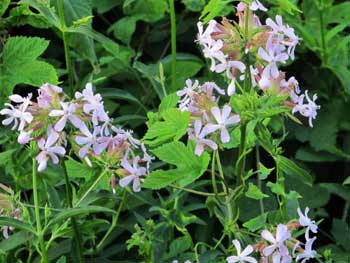Contents:
Common Names | Parts Usually Used | Plant(s) & Culture | Where Found | Medicinal Properties
Legends, Myths and Stories | Uses | Formulas or Dosages | Warning | Bibliography
Scientific Names

- Saponaria officinalis L.
- Pink family
Common Names
- Bouncing Bet
- Bruisewort
- Dog cloves
- Old maids’ pink
- Soap root
Parts Usually Used
The whole plant
Back to Top
Description of Plant(s) and Culture
Soapwort is a wide-spread perennial plant; the finger-thick creeping rootstock produces a reddish, branching stem, which grows from 1-3 feet high and bears opposite, ovate, pointed leaves whose bases clasp the stem. Flat-topped, corymbed clusters of pink, sometimes white or purple, flowers bloom from June to August. Soapwort tolerates poor soil as long as it is well-drained, and full sun or light shade.
Back to Top
Where Found
Grows in waste places and along roadsides and railroad embankments in eastern North America, Asia, and Europe.
Back to Top
Medicinal Properties
Cholagogue, diuretic, expectorant, purgative
Back to Top
Legends, Myths and Stories
A rugged perennial very common along roadsides and near old homesites. It was brought to America by early colonists. The fresh leaves, stems and flowers produce a considerable amount off saponin and cleans as well as leaves a beautiful luster to fabrics. According to an English source, soapwort has been used to clean “filthy”, colorless, decrepit brocade curtains more than 200 years old. The antique curtains were not only cleaned but the original color and luster restored. Bunches of fresh soapwort were put in a muslin bag and boiled in a cauldron until it produced a foaming brown liquid similar to beer. When luke-warm the bag of herbs was removed and liquid squeezed out. The curtains were gently dunked in the saponin liquid. They probably were allowed to steep to loosen embedded dirt. The curtains were then removed and dunked again in several changes of rain water. Never use chemically treated water for silks or fragile materials. The author of this information believed soapwort was safe for washing antique tapestries and silks.
Back to Top
Uses
A decoction is used as an expectorant for respiratory congestion. Has been used for gout; externally as a wash or fomentation for dermatitis, itching skin, furuncles, and tumors. Soapwort has a mild purgative action. Poulticed on acne, eczema, psoriasis, poison-ivy rash, cuts, bruises, helps expel kidney stones, and increases urinary output. Root tea used for lung disease, asthma, gall disease, and jaundice.
Back to Top
Formulas or Dosages
Decoction: boil 1 to 2 tbsp. dried root in 1 cup water. Take 1 tbsp. at a time.
Back to Top
Warning
Soapwort is now believed to be toxic and is only used externally.
Back to Top
Bibliography
![]() American Folk Medicine
American Folk Medicine, by Clarence Meyer, Meyerbooks, publisher, PO Box 427, Glenwood, Illinois 60425, 1973
![]() Culpeper’s Complete Herbal & English Physician: Updated With 117 Modern Herbs
Culpeper’s Complete Herbal & English Physician: Updated With 117 Modern Herbs, by Nicholas Culpeper, Meyerbooks, publisher, PO Box 427, Glenwood, Illinois 60425, 1990, (reprint of 1814)
![]() Eastern/Central Medicinal Plants
Eastern/Central Medicinal Plants, by Steven Foster and James A. Duke., Houghton Mifflin Company, 215 Park Avenue South, New York, NY 10000
![]() The Herb Book
The Herb Book, by John Lust, Bantam Books, 666 Fifth Avenue, New York, NY. copyright 1974.
Herbal Gardening, compiled by The Robison York State Herb Garden, Cornell Plantations, Matthaei Botanical Gardens of the University of Michigan, University of California Botanical Garden, Berkeley., Pantheon Books, Knopf Publishing Group, New York, 1994, first edition
![]() Indian Herbalogy of North America
Indian Herbalogy of North America, by Alma R. Hutchens, Shambala Publications, Inc., Horticultural Hall, 300 Massachusetts Avenue, Boston, Massachusetts 02115, 1973
 Old Ways Rediscovered
Old Ways Rediscovered, by Clarence Meyer, Meyerbooks, publisher, PO Box 427, Glenwood, Illinois 60425, published from 1954, print 1988
![]() Webster’s New World Dictionary
Webster’s New World Dictionary, Third College Edition, Victoria Neufeldt, Editor in Chief, New World Dictionaries: A Division of Simon & Schuster, Inc., 15 Columbus Circle, New York, NY 10023
 The Rodale Herb Book: How to Use, Grow, and Buy Nature’s Miracle Plants (An Organic gardening and farming book)
The Rodale Herb Book: How to Use, Grow, and Buy Nature’s Miracle Plants (An Organic gardening and farming book), edited by William H. Hylton, Rodale Press, Inc. Emmaus, PA, 18049., 1974
